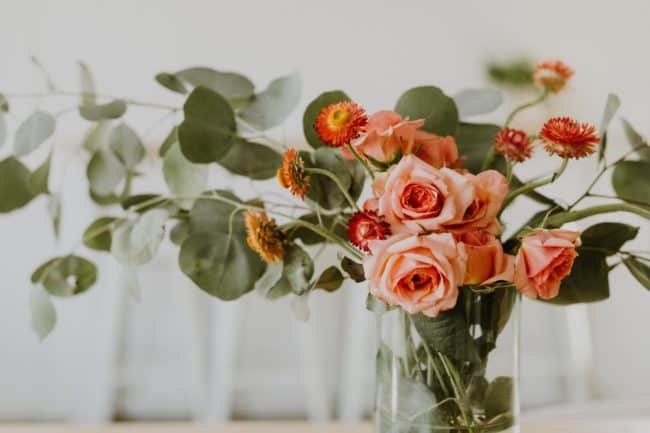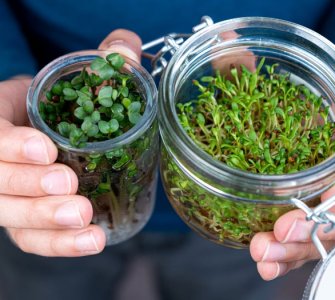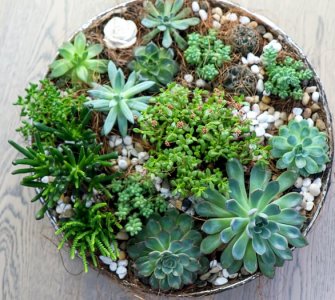If you’re looking to add some colour, beauty and scent to your living space, you’re going to be wondering which are the best roses to grow indoors, in an apartment.
The good news is almost any rose variety can be grown indoors, as long as you have a sunny spot where your rose can receive the light it needs to grow. You can even grow climbing roses indoors! as long as you have a big enough space for a trellis or other kind of support structure. Two of the best roses to grow indoors in an apartment are miniature roses, and patio roses. These can be grown quite happily in pots and don’t take up too much space, which make them perfect for cosy or compact living spaces.
I initially wanted to grow some potted roses in my office – it’s got a window and door for natural light, but it’s still a relatively dark, dull room. But no – sadly, my little dark office isn’t going to provide enough light for any rose to thrive, so I opted for a miniature rose for my kitchen window instead.
Table of Contents
Which Roses Grow Best Indoors?
When you’re looking at how to grow roses indoors you might be thinking about buying roses to grow indoors for the first time.
Two Of The Best Kinds Of Roses For Indoors For Apartments
Growing Miniature Roses In A Pot Indoors
By far the most popular indoor rose type are miniature roses. Miniature roses are good if you want roses that
- Don’t take up too much space / room
- Are relatively easy to look after
- You can keep in a pot on a surface (eg your desk or a kitchen worktop)
Be careful, though, because miniature roses require either the highest possible amount of natural light (6-8 hours of direct sunlight per day, even in winter)!
You can buy an inexpensive pair of grow lights, but this does take away the ‘fuss free’ element of indoor gardening we are trying to aim for here on a prettier petal.
Can You Grow Climbing Roses Indoors?
You can also choose to grow a climbing rose, a marvellous display of its bloom over a trellis being something you must have seen passing by the flower shop or even home decor shops.
Climbing roses look soooo pretty and I’m definitely looking at growing these indoors!
Climbing roses however, once potted, do have to be combined over a wooden trellis, or similar standing structure.
So you should account to have some space for that on either of your walls. Remember climbing roses also tend to grow outwards as well as up!
Here are some general considerations for buying roses that will grow well indoors.
- Choose a climbing rose if have plenty of space and want that ‘wow’ factor
- Grandiflora roses grow tall but if you’re using a pot, the large blooms can tip over
- Miniature roses are possibly the most simple to grow but they do require a lot of sunlight.
What Rose Types Grow Best Indoors?
There are four types of roses that respond particularly well to indoor life:
- Ground cover roses – not prone to growing very tall and very dreamy looking spilling over the corners of its pot, can grow into width
- Worcestershire (pastel yellow bloom)
- Hampshire (red bloom)
- Cheshire (soft pink bloom)
- Miniature rose – will definitely stay small (it’s in the name) 😉
- Cupcake (pale pink bloom) Make sure to search ‘cupcake miniature rose bush’ when buying online or you’ll get actual cupcakes showing up!
- Innocence (white+ dash of pink bloom)
- Caliente (bright red bloom, glossy foliage)
- Stamina (orange red bloom)
- Lavender Lace (mauve bloom)
- Beauty Secret (rich red bloom)
- Cinderella (tiny white bloom)
- Littlest Angel (tiny yellow bloom)
- Patio rose – larger than a miniature, smaller than a standard rose (floribunda that we mentioned earlier, just bred to a smaller scale)
- Wildfire (intense orange bloom)
- Bianco (white bloom)
- Polyantha rose – a short plant with rose clusters
- Arthur Bell (yellow bloom)
- Eutin (this one is amazing, cherry red bloom, 60 cm tall, 100 flowers on a single stem and so, SO fragrant)
- Orange Triumph (orange brown bloom)
- Marie Pavie (easy-care, white blooms, hardy)
Best Rose Types For Indoor Shaded Areas
Not much sunlight in any crook of your apartment, or you have partial shade going on?
There also exist beautiful shade-tolerant rose varieties that can be grown at about 4 hours of daylight a day! So, perfect for you if you live in a country that’s somewhat gloomy in the wintertime (hello UK, my old friend)!
Usually, these are old garden roses that are once-blooming varieties, and require less light.
You should choose prolific bloomers such as floribundas and spray roses (rather than hybrid teas, which really are garden exclusives and will not grow quite so well in a pot).
Make sure to choose pale and pastel blooms which stand out in a partial shade. The best thing about shade-tolerant roses is that they retain their colour and fragrance for a much longer time.
Good floribunda sorts to choose from are:
- Trumpeter (deep red bloom)
- Iceberg (white bloom)
- Golden Wedding (deep yellow bloom)
- English Miss (soft pink bloom)
Spray rose sorts you might enjoy are Alicia (deep pink bloom) and Babe (deep orange bloom)
What Equipment Do I Need To Grow Roses Indoors
Ready to get growing? Here’s what you need to get started!
- sturdy garden gloves (as protection from thorns and chemicals)
- bucket for water, or watering can (you don’t need a spray container, spraying your roses will rot the leaves)
- sharp pruning shears
- pot or container, preferably clay with good drainage)
- pH strips to check soil acidity (optional, but will help)
- soil for the rose (bought or made).
- gravel large stones for the drainage
- fertilizer (balanced houseplant, or especially for roses,)
- a rose cutting or a pre-grown rose plant – variety of your choice
- a windowsill, table or position for the rose in the pot within your home (or on your balcony)
- (optional) ground sulphur/ground limestone to increase or decrease soil acidity
Growing a Rose In Your Apartment From A Store-Purchased Or Pre-Existing Plant
- Dig a hole that is as deep as the pot the rose came in and about 30 cm (1 foot) wider.
- Carefully remove the rose from the pot and gently loosen the roots. If the roots are tightly bound, use a sharp knife to score the sides of the root ball. Gently try to loosen the roots.
- Place the rose plant in the center of the hole with the roots spread out.
- Fill in the hole, gently firm down the soil.
- Water thoroughly at the roots, and apply fresh compost on the top.
Which Is The Best Way To Grow A Rose Plant Indoors In An Apartment? Growing From A Cutting Or From A Store Purchased Plant?
If you want to add some gorgeous roses to your apartment, you’ll most likely be wondering whether to grow some yourself, perhaps from cuttings or a bouquet you have; or whether to head to the store and grow an already-thriving bouquet.
Well, here’s the dilemma you’re faced with when trying to decide on the best way to grow roses indoors in an apartment.
The garden centre or store-purchased plant would seem like the obvious choice. It’s so simple, right? Buy a plant, bring it home, give it plant food and some sunshine, and watch it thrive. Right?
It’s not that easy! The thing is, every rose variety has different needs. Some are made to be insect resistant, some are created to need less sunshine, some only bloom once and then die never to bloom again. So you’re going to need to know exactly the variety of rose you are buying in order to know how to care for it.
Not only that, but the plant you’re looking at might be showing signs of disease, might have been grown with heavy pesticides, and if it’s in full bloom, might soon drop it’s petals and never bloom again, depending on the variety.
So although a store bought plant seems like the easiest choice, it might not be.
How To Tell If Your Store Bought Plant Will Grow In Your Apartment
When buying a plant from a store, grab your phone and google the label. You’ll be able to find out a little bit about the variety and what it needs to thrive indoors instantly. Look for how often it blooms, how much light it needs, and potential problems it might face.
Next, look at the flowers themselves. Store bought roses are often purchased when they are in full bloom but can you see any rosebuds on the plant? Look for the rosebuds to see if your plant will continue to flower.
Next, check the leaves. Are they green and healthy, or are they yellowed at the edges, dropping, or covered in little marks or even an insect or two?
The rose plant’s leaves are a good indication of your plant’s health. While a little yellow around the edges isn’t going to be a sign that your rose plant is dying, it’s going to be a sign that your plant isn’t in full health and perhaps needs more sunlight and a different amount of water or soil.
While you could probably nurse your rose back to life, it’s probably better that you pick a healthy plant to begin with!
So while a store bought plant might seem the obvious choice, it’s not always the right one.
With a cutting, you get to aim for the exact kind of rose you want, perfect for your apartment. Perhaps you even get to give a precious bouquet a new lease of life.
However, they aren’t always the easiest to grow. Here’s how to do it.
Growing a Rose In An Apartment from a Cutting
Timeframe: about 15 minutes to cut and plant a cutting
Total time: about 2 weeks until a cutting has rooted successfully
Not every cutting will grow roots and take hold in the soil enough to be able to grow an entirely new plant, and about 10% of all attempts end up as failures.
You should do multiple cuttings if you are able to, using multiple pots so not to crowd the rose plants together.
- Take a cutting.
Cut a 30 cm (12 inch) long segment of the cane, cutting off the stem at a 45-degree angle. The best cuttings usually come from the sides of the bush. - Remove the flowers.
The flowers along the cutting consume most of the plant’s energy. Remove them to encourage the stem to focus the energy on surviving and sending new roots. - Remove most of the leaves.
All but top two leaflets on the stem should go. After that, cut off the stem JUST ABOVE this top set of leaves. A single pair of leaves needs to be retained so that the stem can continue to photosynthesise and feed itself until a root takes form. - Prepare the stem for rooting.
Use sharp pruners to make a fresh cut on the bottom of the stem, JUST BELOW a stem node (a bump where a new growth will form). Slice up into the bottom of the stem with the pruners about 0.5 cm (1/4 inch) in, splitting the stem into open quarters (make a little cross at the bottom, essentially). - (optional step) Use a rooting hormone. (What is a rooting hormone)?!
Rooting hormone is a powder that when applied to the root, encourages the root to grow and take hold in the soil. It encourages stronger root growth.Powder form is a recommendation for roses. Slightly moisten the split tip of the rose cutting, then dip it into powdered rooting hormone. Shake off any excess.If you want to try entirely natural root hormone, you could try dipping the roots in cinnamon. Ensure the roots are slightly damp to enable the cinnamon to stick.I know it sounds like an old wives’ tale, but you’d be amazed what natural hacks work in gardening (and maybe help us show us what’s good for our own natural health too). - Plant the cutting.
The cutting should be planted in a pot filled at least 15 cm (6 inches) deep with a mixture of coarse sand and vermiculite, or a potting mix designed for roses. Poke a hole in the potting medium, and insert the stem carefully in order not to rub off the rooting hormone. Gently firm the soil around the stem. Water well. - Cover the cutting.
Cover it loosely, pot and the entire thing, with a plastic bag OR a plastic wrap. Keep the soil moist and keep the plastic off the leaves. The bag or wrap needs to be slightly vented so that condensation has a way out – if sealed too tightly, the stem might rot. You can also use a plastic bottle, with the end cut off. - Transplant the cutting.
The cutting can be transplanted into a pot as soon as the roots are firmly established, or when you see new leaf sprouts begin to appear along the stem.
So now you know how to choose the best roses for apartments indoors. If you want to know how to ensure it thrives and how to give it proper care, you’ll want to check out this post right here.



